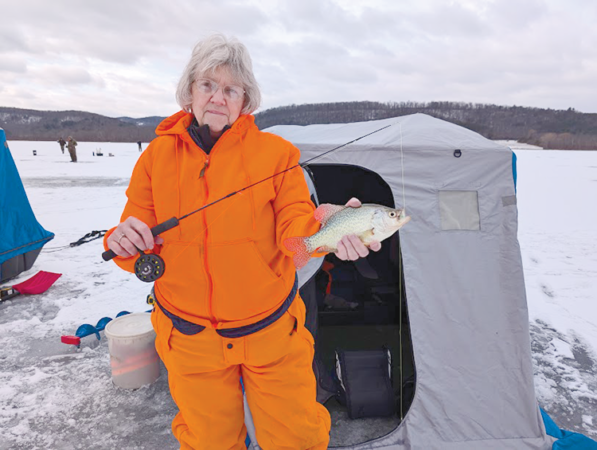I’m sure it’s no secret that me, my wife, and several of my buddies love to spend time on the ice during the winter months.
Over the last few years, safe ice has been hard to come by, but fortunately, we were able to get on the ice several days at the end of December. A warm spell of rain wiped out our hard water, but the recent cold spell has put us back on the ice.
Certainly, in this early ice fishing season, it’s very important to use caution since the ice thickness is not uniform throughout the surface of the lake or pond.
This past Saturday, we had at least four inches of hard, clear ice, and the fishing was pretty decent.
While I have ice fished for all kinds of fish with different equipment and various baits and lures, one of my favorite hard water pursuits is panfishing. When I say panfish, I’m basically referring to bluegills, crappies, and perch. Panfish are highly sought after by the ice-fishing crowd, and for good reasons.
For one, panfish are often very active even during those bitterly cold winter months, albeit they will often be in deeper water or in schools at mid-depth or lower. The crappies tend to be more active and willing to take your offerings early in the day and again late in the day. The bluegills and perch seem to show up at almost any time of the day.
Besides being fairly active and catchable, panfish are also highly sought after during the ice-fishing season because they are excellent dining fare. When properly filleted and skinned, they can be prepared in a number of different ways. Simply dipping the fillets in eggs and then cracker crumbs and then frying them in olive oil is hard to beat. To be honest, once they have been prepared and fried, I can’t tell the difference between one species or the other — they all taste great. Ten panfish of average size provide 20 fillets; for my wife and I, that’s a good meal. Whatever is left over is my lunch the next day.
A couple of factors go a long way towards helping to put some fish in that frying pan. Keeping your ice rigs fairly light and sensitive is a good idea. It’s not at all unusual for panfish to hit very lightly, and detecting a strike can be difficult with gear that is not sensitive. Yes, you can use a small float or bobber and be ready to set the hook as soon as it pops, but I like to fish by keeping a tight line and feeling for a hit. Sometimes, those hits are very light and barely detectable. I’ve also hooked fish even when I didn’t feel any kind of strike, but instead, the line simply began moving to one side of the ice hole. I always keep a tight line to detect hits and watch for that line movement.
Finally, you want to keep your ice fishing lures small enough for the panfish to get them in their mouth. Bluegills especially have small mouth openings, while crappies may have a little bigger bite, but I still like small ice jigs with some kind of bait attached. Mealworms, wax worms, butter worms, and small chunks of earthworms or small pieces of night crawlers slipped on the tiny jig will likely add to the action.
Well, hopefully, we will have some ice for the rest of winter, providing it stays cold enough; I’m already making plans for my next outing.




